Analysis of Coal Floor Fault Activation Inducing Water Inrush Using Microseismic Monitoring—A Case Study in Zhaogu No. 1 Coal Mine of Henan Province, China
Abstract
1. Introduction
2. Engineering Conditions of Zhaogu No. 1 Coal Mine
3. Floor Fault Activation Law Based on Microseismic Monitoring
3.1. The Layout of Microseismic System of 16001 Working Face
3.2. Monitoring Results of Water Inflow and Microseismic Events
3.3. Analysis of Microseismic Monitoring Results
4. Numerical Simulation of Failure Behaviors of the Floor Fault
4.1. Simulation Model and Sheme
4.2. Analysis of Simulation Results
5. Conclusions
Author Contributions
Funding
Institutional Review Board Statement
Informed Consent Statement
Data Availability Statement
Conflicts of Interest
References
- Wei, Q.; Li, W.; Li, T.; Chang, J.; Wang, Q. Effects of Coal Mining on Shallow Water Resources in Semiarid Regions: A Case Study in the Shennan Mining Area, Shaanxi, China. Mine Water Environ. 2016, 36, 104–113. [Google Scholar] [CrossRef]
- Wu, Q.; Guo, X.; Shen, J.; Xu, S.; Liu, S.; Zeng, Y. Risk assessment of water inrush from aquifers underlying the Gushuyuan coal mine, China. Mine Water Environ. 2017, 36, 96–103. [Google Scholar] [CrossRef]
- Yin, H.; Sang, S.; Xie, D.; Zhao, H.; Li, S.; Li, H.; Zhuang, X. A numerical simulation technique to study fault activation characteristics during mining between fault bundles. Environ. Earth Sci. 2019, 78, 148. [Google Scholar] [CrossRef]
- Lee, D.K.; Yim, G.J.; Ji, S.W.; Cheong, Y.W. Study on distribution characteristics of some water parameters properties of mine drainage in an oxidation pond, Hwangji-Yuchang coal mine, South Korea. Environ. Earth Sci. 2013, 68, 241–249. [Google Scholar] [CrossRef]
- Liu, P.; Tao, Y.; Shang, M.; Yao, M. The calculation of mine water yield using the non-continuous flow theory. Environ. Earth Sci. 2014, 71, 975–981. [Google Scholar] [CrossRef]
- Guo, B.; Cheng, T.; Wang, L.; Luo, T.; Yang, X. Physical simulation of water inrush through the mine floor from a confined aquifer. Mine Water Environ. 2018, 37, 577–585. [Google Scholar] [CrossRef]
- Sainoki, A.; Mitri, H.S. Dynamic behaviour of mining-induced fault slip. Int. J. Rock Mech. Min. Sci. 2014, 66, 19–29. [Google Scholar] [CrossRef]
- Hofmann, G.; Scheepers, L. Simulating fault slip areas of mining induced seismic tremors using static boundary element numerical modelling. Min. Technol. 2011, 120, 53–64. [Google Scholar] [CrossRef]
- Hu, X.; Wang, L.; Lu, Y.; Yu, M. Analysis of insidious fault activation and water inrush from the mining floor. Int. J. Min. Sci. Technol. 2014, 24, 477–483. [Google Scholar] [CrossRef]
- Islam, M.; Shinjo, R. Mining-induced fault reactivation associated with the main conveyor belt roadway and safety of the Barapukuria Coal Mine in Bangladesh: Constraints from BEM simulations. Int. J. Coal Geol. 2009, 79, 115–130. [Google Scholar] [CrossRef]
- Zhao, J.; Chen, J.; Xing, H.; Zhao, Z.; Zhang, X. Dynamic mechanical response and movement evolution characteristics of fault systems in the coal mining process. Pure Appl. Geophys. 2022, 179, 233–246. [Google Scholar] [CrossRef]
- Li, L.; Yang, T.; Liang, Z.; Zhu, W.; Tang, C. Numerical investigation of groundwater outbursts near faults in underground coal mines. Int. J. Coal Geol. 2011, 85, 276–288. [Google Scholar] [CrossRef]
- Chen, L.; Feng, X.; Xu, D.; Zeng, W.; Zheng, Z. Prediction of water-inrush risk areas in process of mining under the unconsolidated and confined aquifer: A case study from the Qidong coal mine in China. Environ. Earth Sci. 2016, 75, 706. [Google Scholar] [CrossRef]
- Sun, W.; Liu, H.; Cao, Z.; Yang, H.; Li, J. Mechanism Analysis of Floor Water Inrush Based on Criteria Importance though Intercrieria Correlation. Water 2023, 15, 232. [Google Scholar] [CrossRef]
- Chen, J.; Zhang, Y.; Ma, K.; Tang, D.; Li, H.; Zhang, C. Analysis of Mining Crack Evolution in Deep Floor Rock Mass with Fault. Geofluids 2021, 2021, 5583877. [Google Scholar] [CrossRef]
- Alber, M.; Fritschen, R.; Bischoff, M.; Meier, T. Rock mechanical investigations of seismic events in a deep longwall coal mine. Int. J. Rock Mech. Min. Sci. 2009, 46, 408–420. [Google Scholar] [CrossRef]
- Donnelly, L.; Culshaw, M.; Bell, F. Longwall mining-induced fault reactivation and delayed subsidence ground movement in British coalfields. Q. J. Eng. Geol. Hydrogeol. 2008, 41, 301–314. [Google Scholar] [CrossRef][Green Version]
- Liu, S.; Liu, W.; Yin, D. Numerical simulation of the lagging water inrush process from insidious fault in coal seam floor. Geotech. Geol. Eng. 2017, 35, 1013–1021. [Google Scholar] [CrossRef]
- Zhou, Q.; Herrera, J.; Hidalgo, A. The numerical analysis of fault-induced mine water inrush using the extended finite element method and fracture mechanics. Mine Water Environ. 2018, 37, 185–195. [Google Scholar] [CrossRef][Green Version]
- Zhang, P.; Zhu, X.; Sun, W.; Yang, H.; Yang, F. Study on mechanism of delayed water inrush caused by mining-induced filling fault activation. Coal Sci. Technol. 2022, 50, 136–143. (In Chinese) [Google Scholar] [CrossRef]
- Li, C.; Xu, Z. Numerical modeling and investigation of fault-induced water inrush hazard under different mining advancing directions. Mathematics 2022, 10, 1561. [Google Scholar] [CrossRef]
- Song, W.; Liang, Z. Theoretical and numerical investigations on mining-induced fault activation and groundwater outburst of coal seam floor. Bull. Eng. Geol. Environ. 2021, 80, 5757–5768. [Google Scholar] [CrossRef]
- Hu, Y.; Sun, J.; Liu, W.; Wei, D. The evolution and prevention of water inrush due to fault activation at working face No. II 632 in the Hengyuan coal mine. Mine Water Environ. 2019, 38, 93–103. [Google Scholar] [CrossRef]
- Islam, M.; Hayashi, D.; Kamruzzaman, A. Finite element modeling of stress distributions and problems for multi-slice longwall mining in Bangladesh, with special reference to the Barapukuria coal mine. Int. J. Coal Geol. 2009, 78, 91–109. [Google Scholar] [CrossRef]
- Muzik, J.; Seidlova, A.; Kudelcikova, M.; Kongar-Syuryun, C.; Mihalik, J. Flood hazard calculation by using a digital terrain model. IOP Conf. Ser. Earth Environ. Sci. 2021, 906, 012067. [Google Scholar] [CrossRef]
- Rybak, J.; Kongar-Syuryun, C.; Tyulyaeva, Y.; Khayrutdinov, A.; Akinshin, I. Geomechanical substantiation of parameters of technology for mining salt deposits with a backfill. Min. Sci. 2021, 28, 19–32. [Google Scholar] [CrossRef]
- Li, A.; Ji, B.; Ma, Q.; Liu, C.; Wang, F.; Ma, L.; Mu, P.; Mou, L.; Yang, Y.; Ding, X. Design of longwall coal pillar for the prevention of water inrush from the seam floor with through fault. Geofluids 2021, 2021, 5536235. [Google Scholar] [CrossRef]
- Leśniak, A.; Isakow, Z. Space–time clustering of seismic events and hazard assessment in the Zabrze-Bielszowice coal mine, Poland. Int. J. Rock Mech. Min. Sci. 2009, 46, 918–928. [Google Scholar] [CrossRef]
- Sun, J.; Wang, L.; Hou, H. Application of micro-seismic monitoring technology in mining engineering. Int. J. Min. Sci. Technol. 2012, 22, 79–83. [Google Scholar] [CrossRef]
- Zhou, J.; Yang, T.; Zhang, P.; Xu, T.; Wei, J. Formation process and mechanism of seepage channels around grout curtain from microseismic monitoring: A case study of Zhangmatun iron mine, China. Eng. Geol. 2017, 226, 301–315. [Google Scholar] [CrossRef]
- Liu, X.; Tang, C.A.; Li, L.; Lv, P.; Liu, H. Microseismic monitoring and 3D finite element analysis of the right bank slope, Dagangshan Hydropower Station, during reservoir impounding. Rock Mech. Rock Eng. 2017, 50, 1901–1917. [Google Scholar] [CrossRef]
- Cheng, S.; Li, S.; Li, L.; Shi, S.; Zhou, Z.; Wang, J. Study on energy band characteristic of microseismic signals in water inrush channel. J. Geophys. Eng. 2018, 15, 1826–1834. [Google Scholar] [CrossRef][Green Version]
- Liu, W.; Li, Y. Theoretical and Simulation Investigations of Water Inrushes Due to Fault Activation by Mining. Mine Water Environ. 2023, 42, 146–157. [Google Scholar] [CrossRef]
- Liu, J.; Feng, X.; Li, Y.; Xu, S.; Sheng, Y. Studies on temporal and spatial variation of microseismic activities in a deep metal mine. Int. J. Rock Mech. Min. Sci. 2013, 60, 171–179. [Google Scholar] [CrossRef]
- Cheng, A.; Gao, Y.; Liang, X.; Liu, C.; Wu, Q.; Zhu, Q. Identification of potential water inrush areas in coal floor by using microseismic monitoring technique. Chin. J. Geotech. Eng. 2014, 36, 1727–1732. (In Chinese) [Google Scholar] [CrossRef]
- Sun, Y.; Zuo, J.; Li, Y.; Liu, C.; Li, Y.; Shi, Y. Micro-seismic monitoring on fractured zone and water inrush mechanism analysis of deep mining above aquifer in Xingdong coalmine. Rock Soil Mech. 2017, 38, 2335–2342. (In Chinese) [Google Scholar] [CrossRef]
- Wang, Y.; Yu, S.; Wang, S.; Huang, K.; Tang, C. Application of microseismic monitoring technology in water inrush warning of coal mine floor. Coal Sci. Technol. 2018, 48, 68–73. (In Chinese) [Google Scholar] [CrossRef]
- Yu, R.; Qian, J.; Liu, L.; Zha, H.; Li, N. Microseismic Precursors of Coal Mine Water Inrush Characterized by Different Waveforms Manifest as Dry to Wet Fracturing. Int. J. Environ. Res. Public Health 2022, 19, 14291. [Google Scholar] [CrossRef]

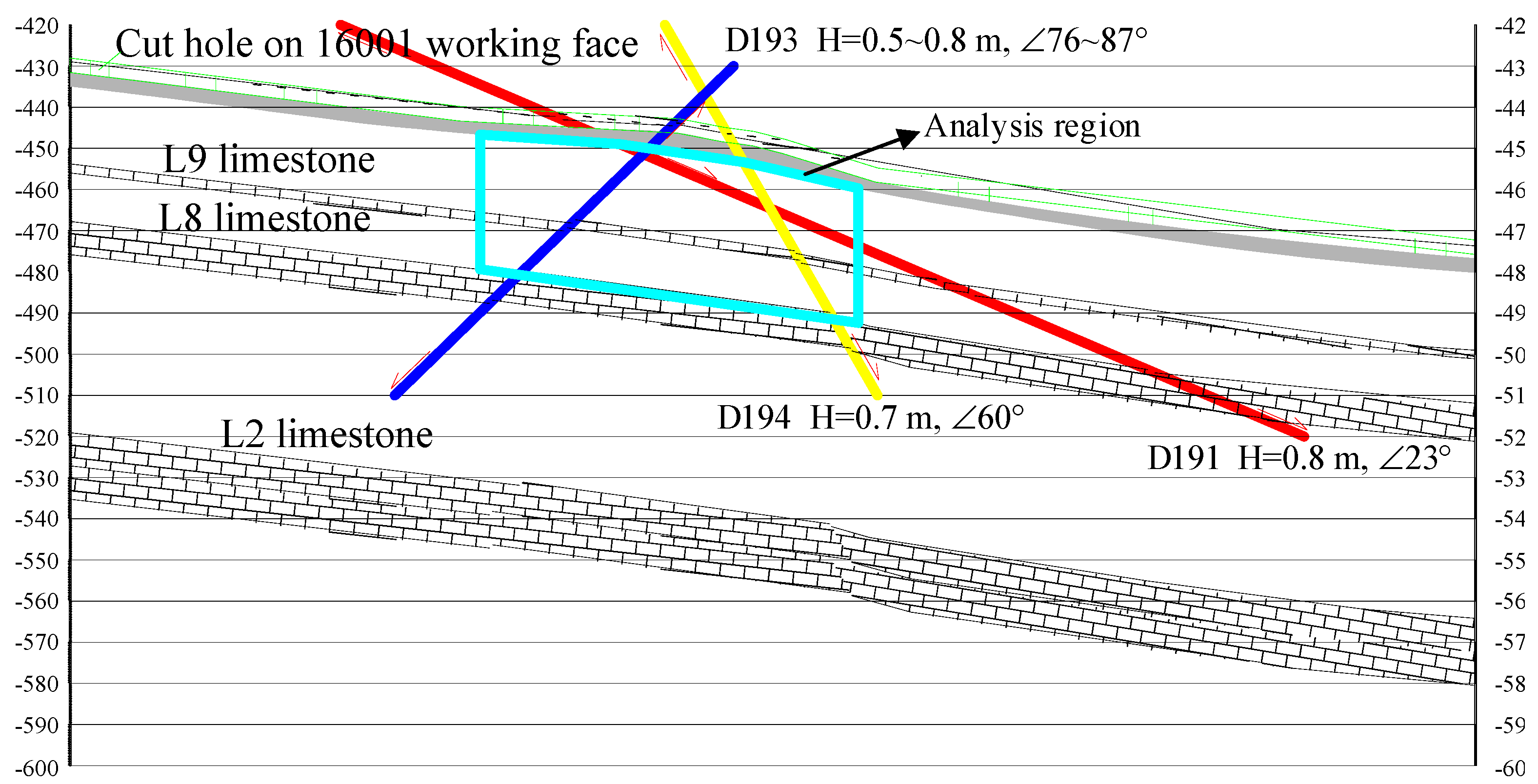
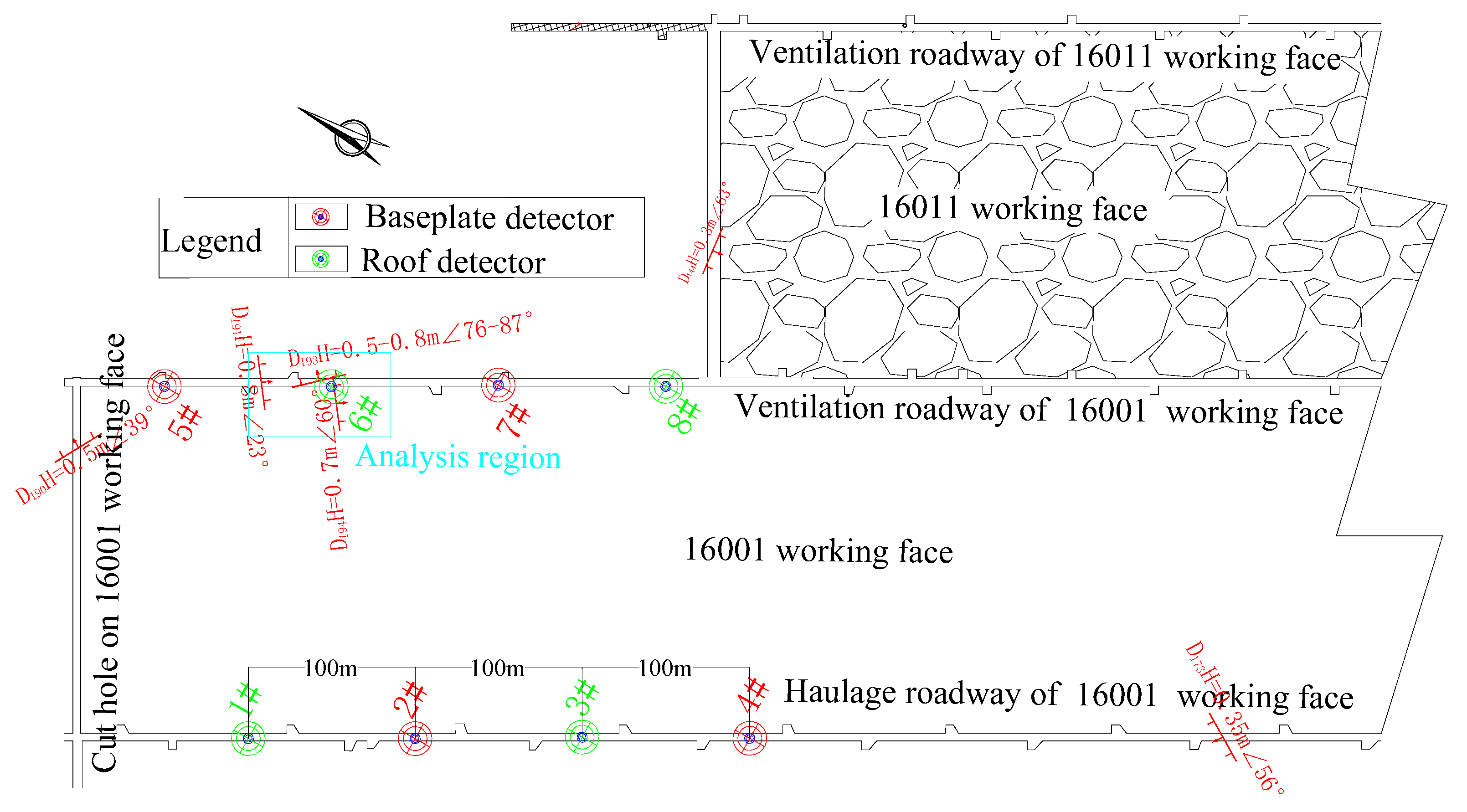
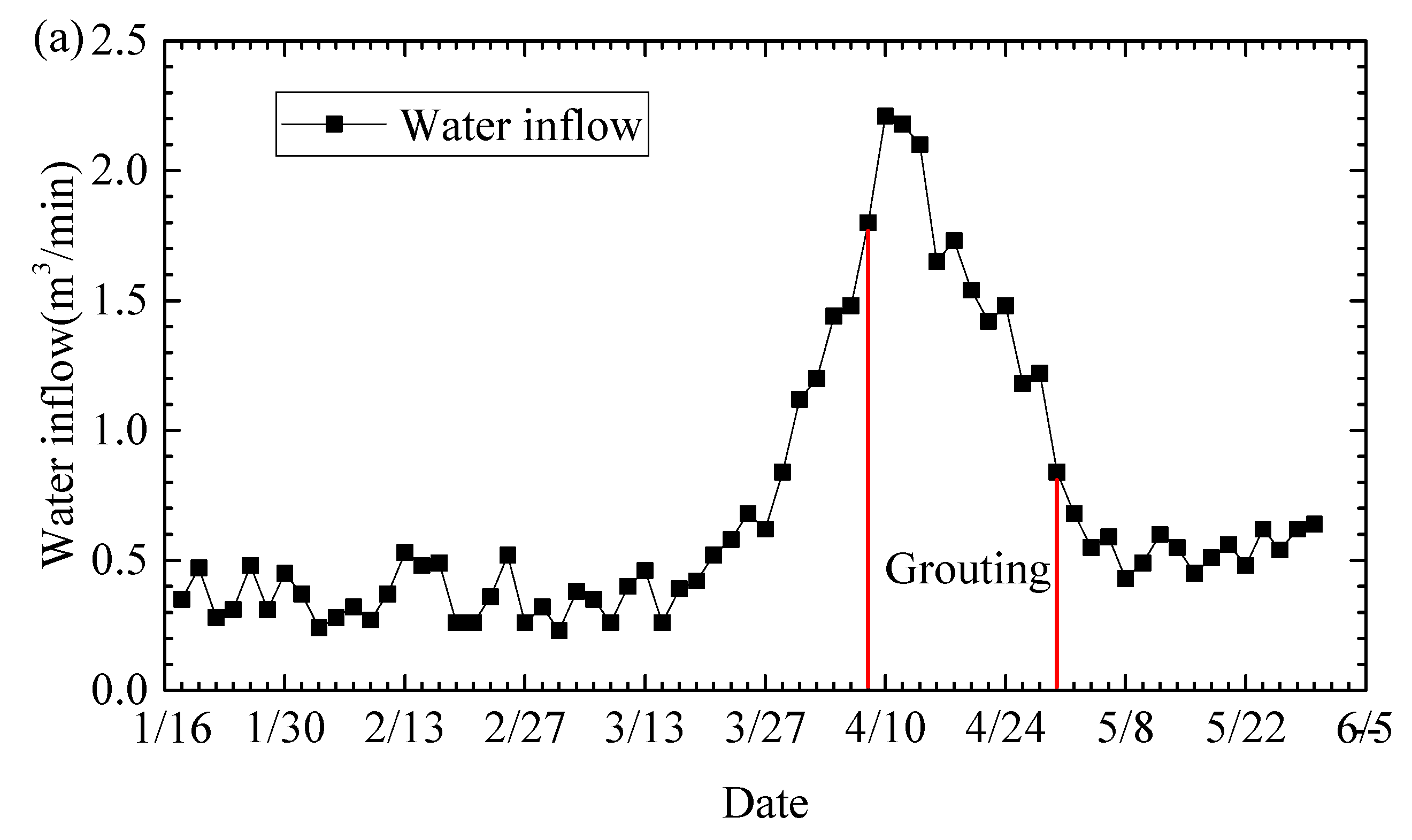
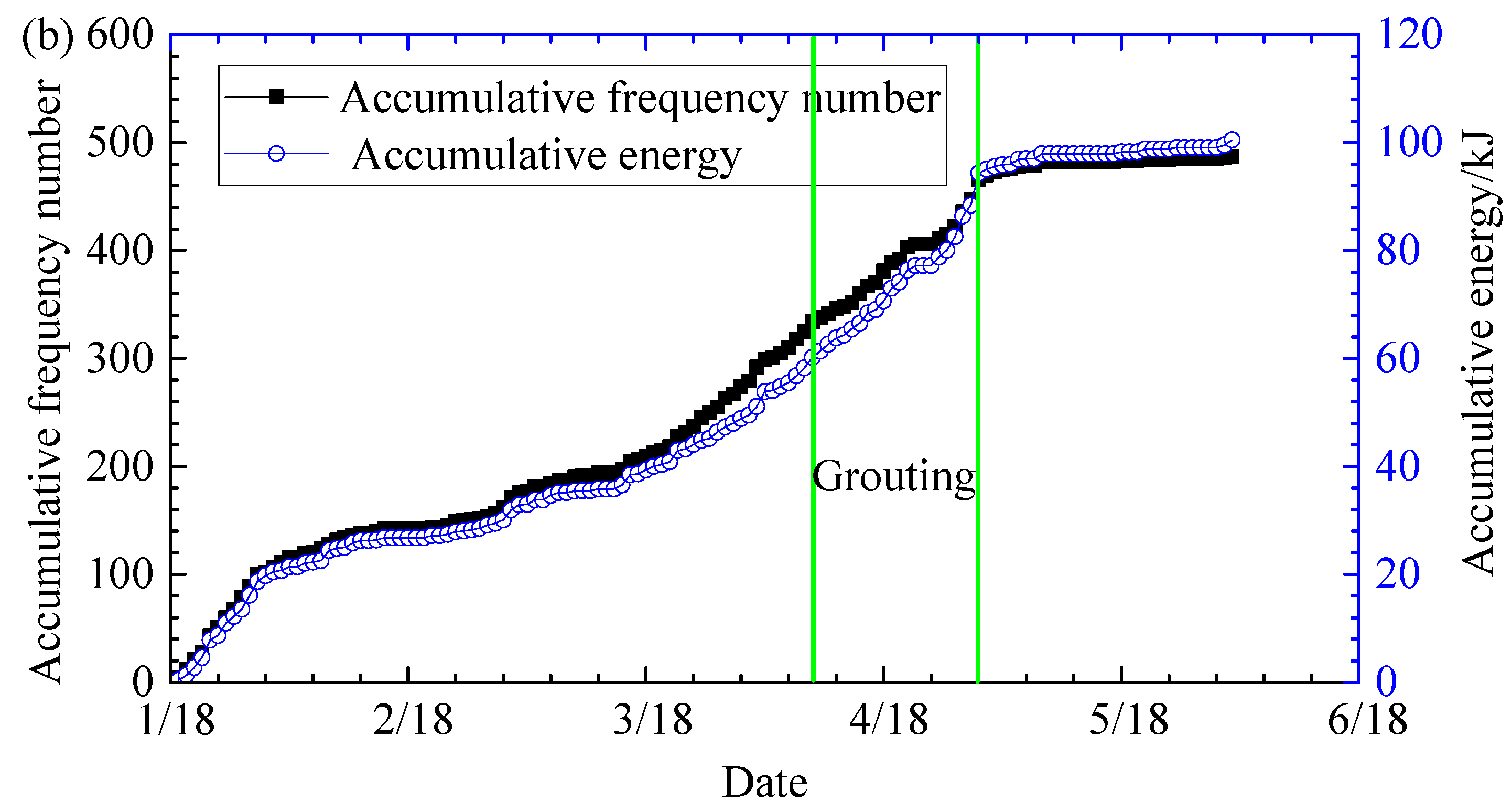
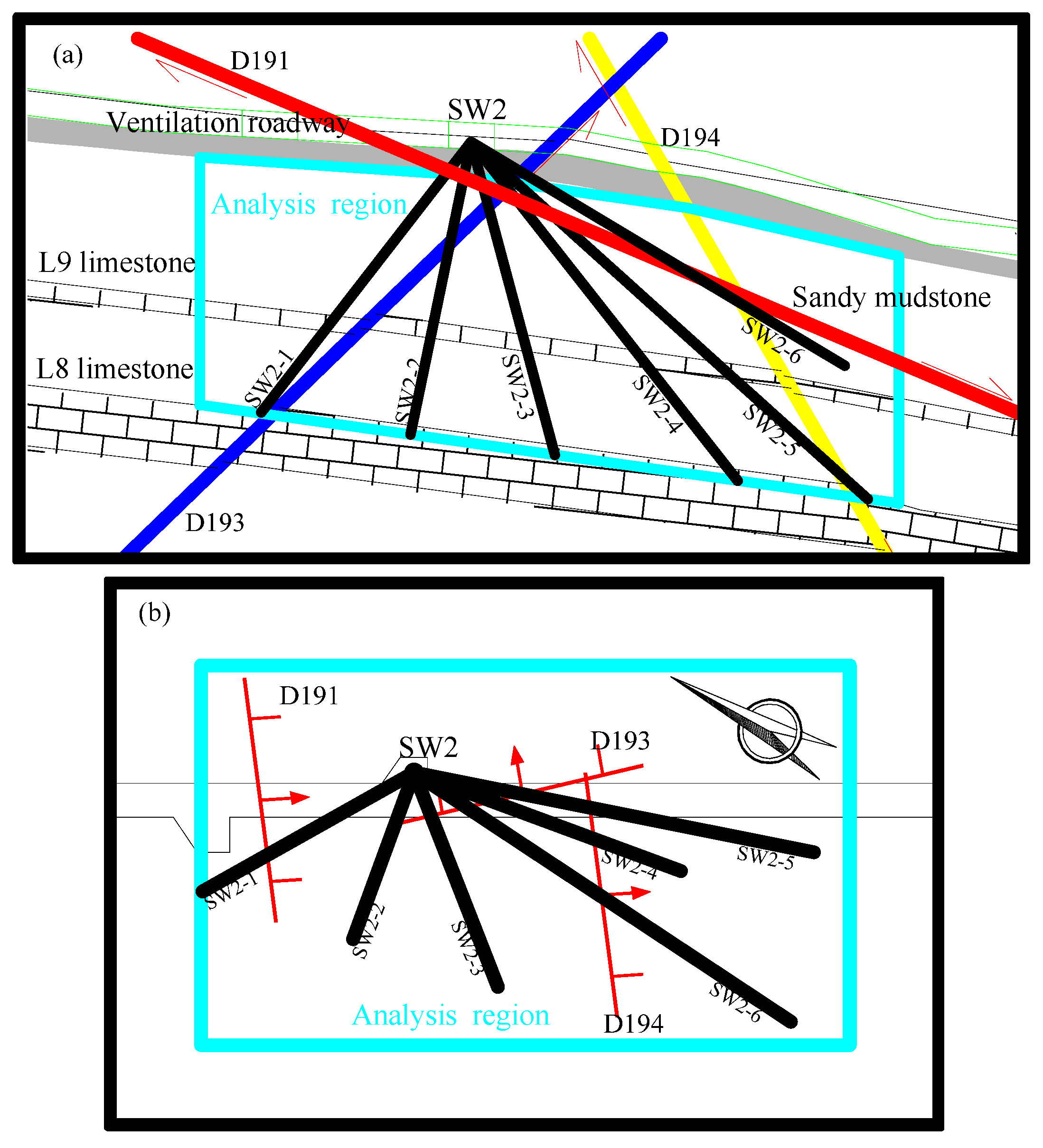
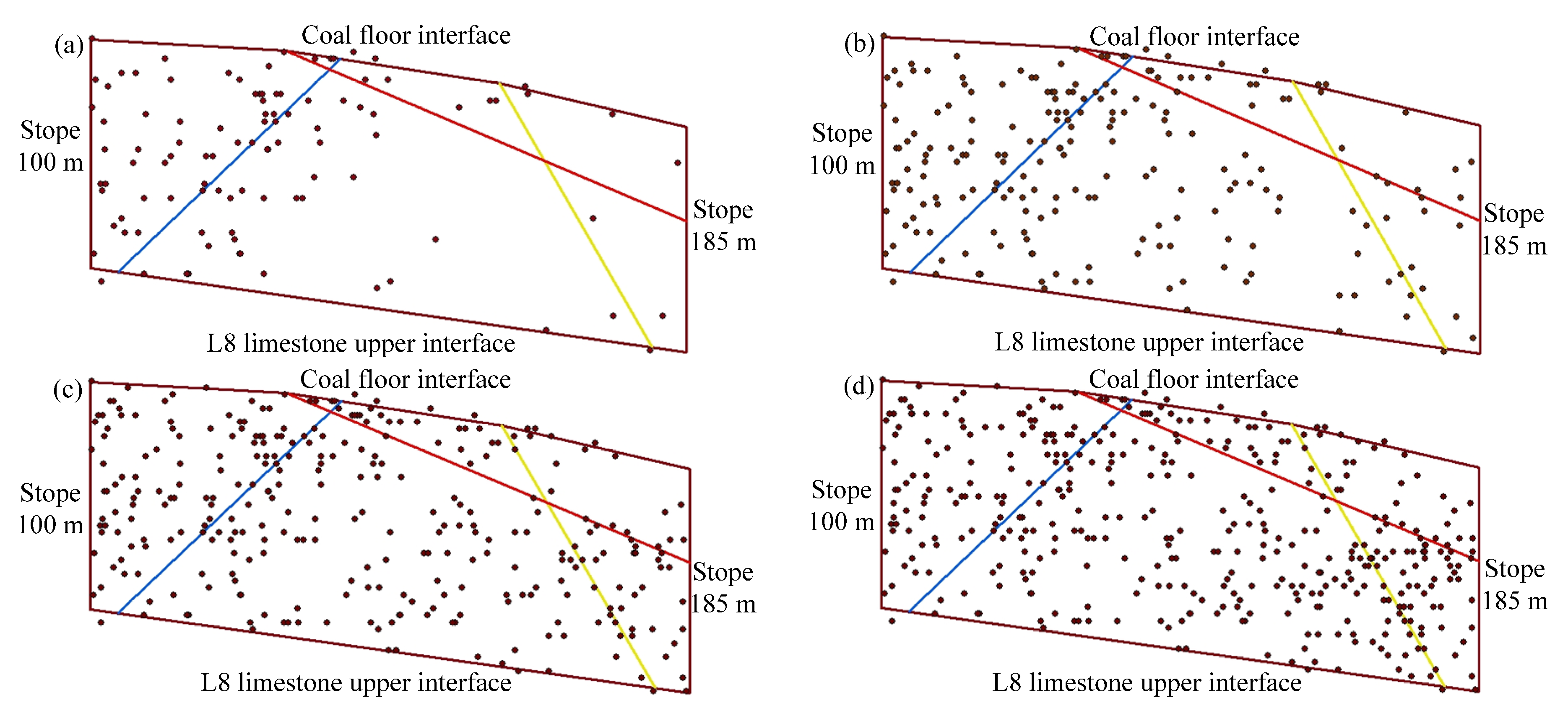

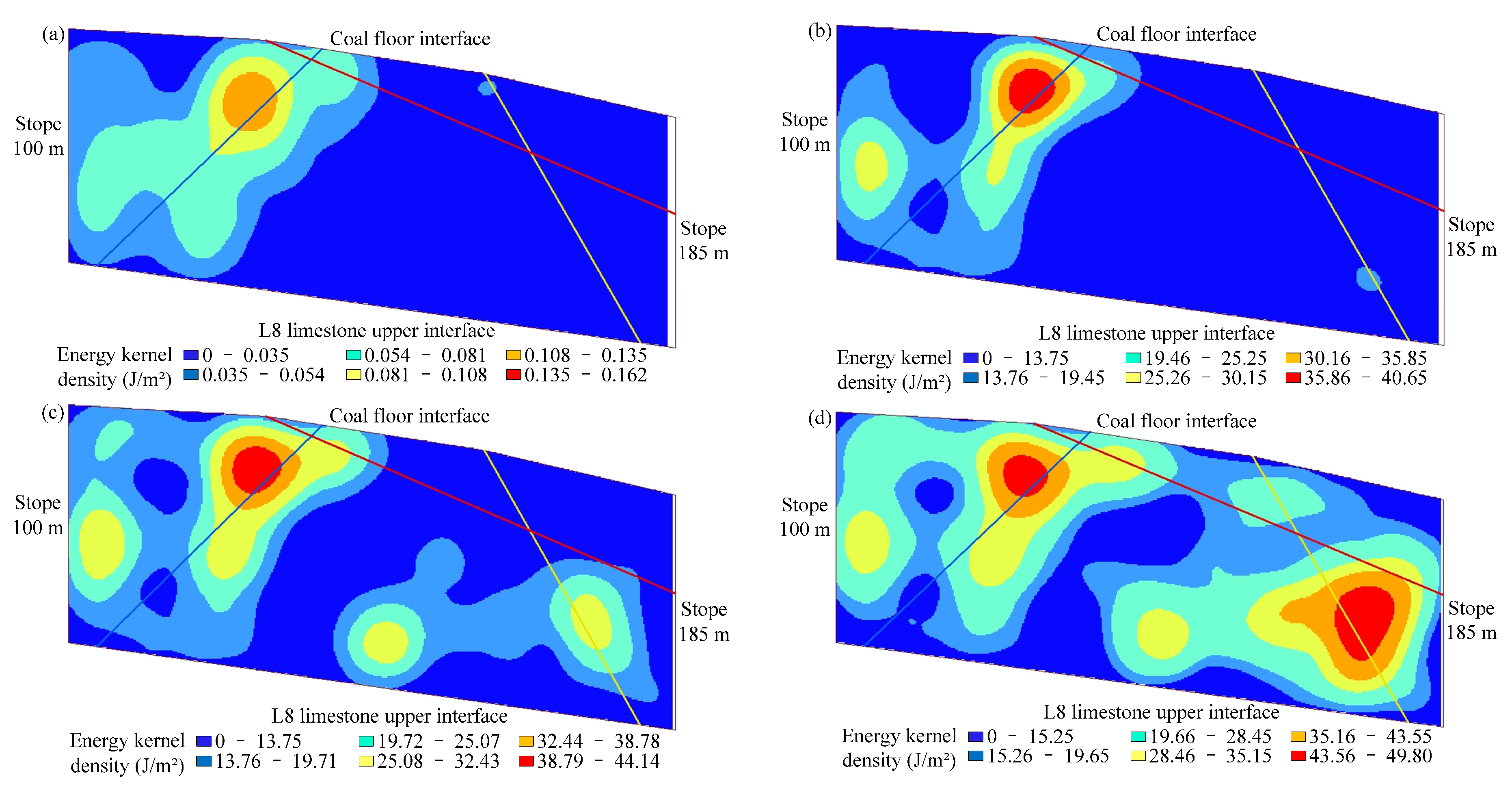


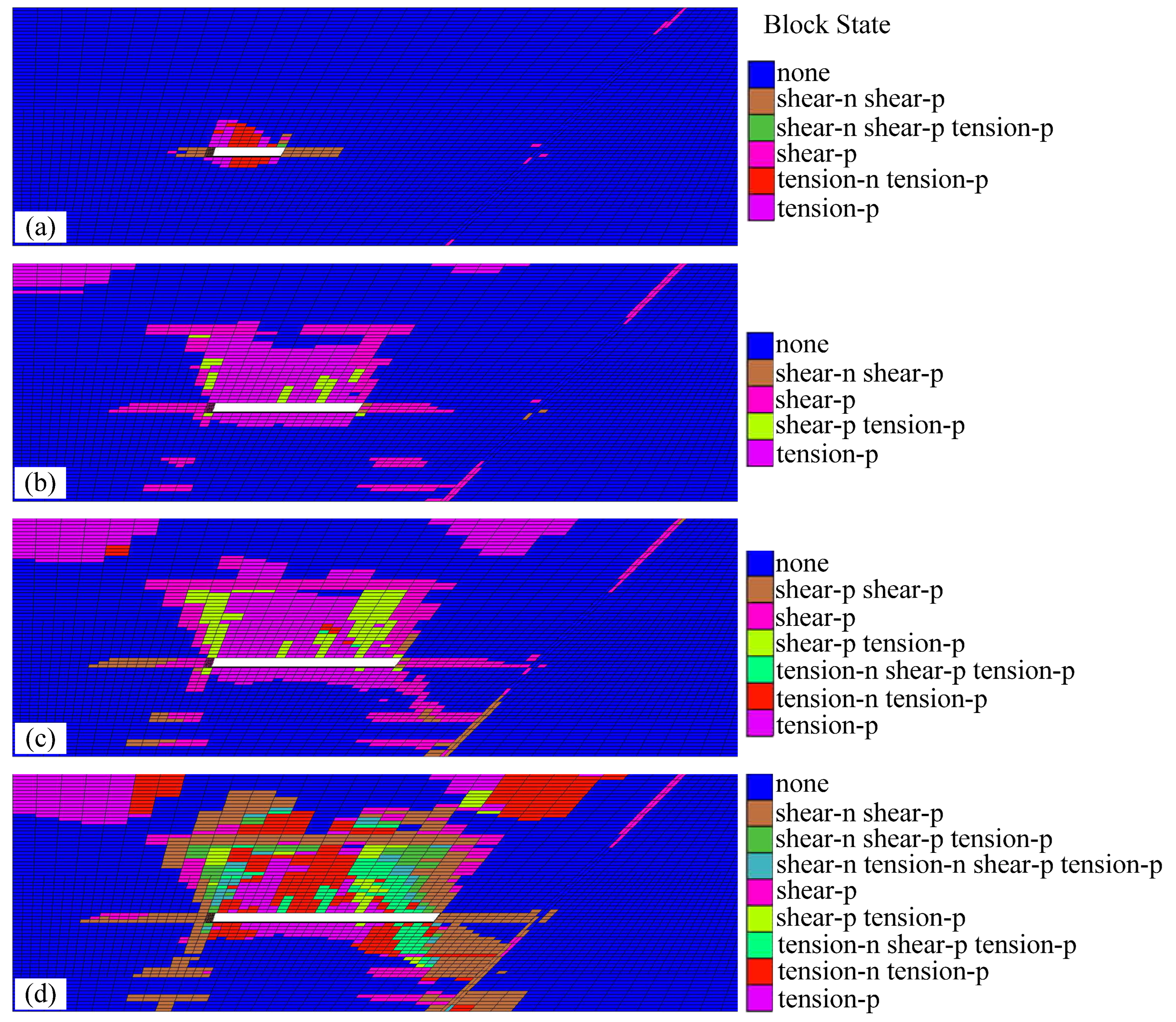
| No. | Name | Strike (°) | Trend (°) | Dip Angle (°) | Difference of Level (m) |
|---|---|---|---|---|---|
| 1 | D191 | 235 | 145 | 23 | 0.8 |
| 2 | D193 | 139 | 49 | 76~87 | 0.5~0.8 |
| 3 | D194 | 235 | 145 | 60 | 0.7 |
| Date | Measured Wave Velocity (m/s) | Mean (m/s) | |||
|---|---|---|---|---|---|
| 24 January | 2# | 3# | 1# | 7# | 3422 |
| 3328 | 3510 | 3395 | 3456 | ||
| 4 February | 6# | 7# | 5# | 2# | 3453 |
| 3525 | 3290 | 3448 | 3550 | ||
| Date | X | Y | Z | Average Error | |
|---|---|---|---|---|---|
| 24 January calibration | Measured coordinates | 462,872.49 | 3,920,374.48 | −436.0 | |
| Oriented coordinates | 462,873.96 | 3,920,378.28 | −435.94 | ||
| Error | 1.47 | 3.80 | 0.052 | 1.77 | |
| 4 February calibration | Measured coordinates | 462,703.45 | 3,920,239.89 | −464.28 | |
| Oriented coordinates | 462,705.62 | 3,920,237.60 | −465.75 | ||
| Error | 2.16 | 2.28 | 1.473 | 1.97 |
| Serial Number | Drilling Number | Drilling Depth (m) | Drilling Azimuth (°) | Dip Angle (°) | Final Hole Location | Grouting Pressure (MPa) | Grouting Amount (m3) |
|---|---|---|---|---|---|---|---|
| 1 | SW2-1 | 47.9 | 302 | −48.2 | L8 Limestone | 8 | 62 |
| 2 | SW2-2 | 45.2 | 261 | −58.8 | L8 Limestone | 8 | 34.1 |
| 3 | SW2-3 | 51.3 | 220 | −53.7 | L8 Limestone | 8 | 113.2 |
| 4 | SW2-4 | 58.5 | 171 | −49.9 | L8 Limestone | 8 | 108.5 |
| 5 | SW2-5 | 71.3 | 162 | −41.4 | L8 Limestone | 8 | 18.6 |
| 6 | SW2-6 | 66.3 | 185 | −26.5 | Sandy mudstone | 8 | 79.1 |
| Lithology | Density (ρ/kgm-3) | Young’s Modulus (E/GPa) | Poisson’s Ratio (μ) | Cohesion (C/MPa) | Friction (φ/°) | Tension (σ/MPa) |
|---|---|---|---|---|---|---|
| Sandy mudstone | 2610 | 31.1 | 0.22 | 8.2 | 36 | 2.6 |
| Fine sandstone | 2520 | 33.0 | 0.26 | 2.8 | 37 | 1.8 |
| L8 limestone | 2680 | 48.0 | 0.30 | 34 | 40 | 5.1 |
| Siltstone | 2670 | 29.0 | 0.24 | 8.0 | 42 | 2.8 |
| L9 limestone | 2680 | 45.0 | 0.30 | 36 | 41 | 5.0 |
| Coal | 1450 | 4.0 | 0.25 | 3.0 | 20 | 1.2 |
| Mudstone | 2660 | 26.0 | 0.24 | 8.5 | 32 | 1.4 |
| Medium sandstone | 2640 | 28.5 | 0.26 | 8.5 | 33 | 1.7 |
| Fault | 2200 | 2.7 | 0.40 | 0.9 | 40 | 0.2 |
Disclaimer/Publisher’s Note: The statements, opinions and data contained in all publications are solely those of the individual author(s) and contributor(s) and not of MDPI and/or the editor(s). MDPI and/or the editor(s) disclaim responsibility for any injury to people or property resulting from any ideas, methods, instructions or products referred to in the content. |
© 2023 by the authors. Licensee MDPI, Basel, Switzerland. This article is an open access article distributed under the terms and conditions of the Creative Commons Attribution (CC BY) license (https://creativecommons.org/licenses/by/4.0/).
Share and Cite
Xin, C.; Jiang, F.; Zhai, C.; Chen, Y. Analysis of Coal Floor Fault Activation Inducing Water Inrush Using Microseismic Monitoring—A Case Study in Zhaogu No. 1 Coal Mine of Henan Province, China. Sustainability 2023, 15, 7361. https://doi.org/10.3390/su15097361
Xin C, Jiang F, Zhai C, Chen Y. Analysis of Coal Floor Fault Activation Inducing Water Inrush Using Microseismic Monitoring—A Case Study in Zhaogu No. 1 Coal Mine of Henan Province, China. Sustainability. 2023; 15(9):7361. https://doi.org/10.3390/su15097361
Chicago/Turabian StyleXin, Chongwei, Fuxing Jiang, Changzhi Zhai, and Yan Chen. 2023. "Analysis of Coal Floor Fault Activation Inducing Water Inrush Using Microseismic Monitoring—A Case Study in Zhaogu No. 1 Coal Mine of Henan Province, China" Sustainability 15, no. 9: 7361. https://doi.org/10.3390/su15097361
APA StyleXin, C., Jiang, F., Zhai, C., & Chen, Y. (2023). Analysis of Coal Floor Fault Activation Inducing Water Inrush Using Microseismic Monitoring—A Case Study in Zhaogu No. 1 Coal Mine of Henan Province, China. Sustainability, 15(9), 7361. https://doi.org/10.3390/su15097361








